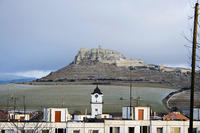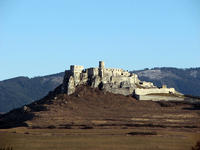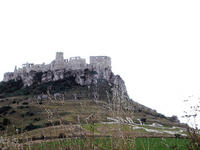You are in: Europe -> Slovakia -> Town of Spišské Po... , and traditional search or Image Gallery will yield results of this site only
Town of Spišské Podhradie, Spišský Hrad and its Associated Cultural Monuments
| Site number: | 620 |
|
| Type of site: | Cultural | |
| Date: | 13-14th-century | |
| Date of Inscription: | 1993 | |
| Location: | Europe, Slovakia, Prešov Region (formerly Spiš region), Levoca District | |
Up to 75 images are shown here. Click on each for more details or on Image Gallery for more images.
| Description: | One of Eastern Europe’s largest ensembles of 13th- and 14th-century military, political and religious buildings; Spissky Hrad has remarkably managed to maintain most of its Romanesque and Gothic architecture intact. --WHMNet paraphrase from the description at WHC Site, where additional information is available. For 360 degree imaging of this site, click here. | |
| The ruins of Spiš Castle (Slovak: Spišský hrad) in eastern Slovakia form one of the largest castle sites in Central Europe. The castle is situated above the town of Spišské Podhradie and the village of Žehra, in the region known as Spiš. It was included in the UNESCO list of World Heritage Sites in 1993 (together with the adjacent locations of Spišská Kapitula, Spišské Podhradie and Žehra). Spiš Castle was built in the 12th century on the site of an earlier Slavic castle. It was the political, administrative, economic and cultural centre of Spiš county. Before 1464, it was owned by the Hungarian kings, afterwards (until 1528) by the Zápolya (Zápoľský) family, the Thurzo family (1531-1635), the Csáky family (1638-1945), аnd (since 1945) by the State. Originally a Romanesque stone castle with fortifications, a two-story Romanesque palace and a three nave Romanesque-Gothic basilica were constructed in the area by the second half of the 13th century. A second extramural settlement was built in the 14th century, by which the castle area was doubled. The castle was completely rebuilt in the 15th century; the castle walls were heightened and a third extramural settlement was constructed. A late Gothic chapel was added around 1470. The Zápolyas performed late Gothic transformations, which made the upper castle into a comfortable family residence, typical of late Renaissance residences of the 16th and 17th centuries. In 1780, the castle burned down and has been in ruins since. The castle was partly reconstructed in the second half of the 20th century, and extensive archaeological research was carried out on the site. The reconstructed sections house displays of the Spiš Museum. --Wikipedia. Text is available under the Creative Commons Attribution-ShareAlike License. | ||
| Source: | http://whc.unesco.org/en/list/620 | |
| Reference: | 1. UNESCO World Heritage Center, Site Page. | |
















